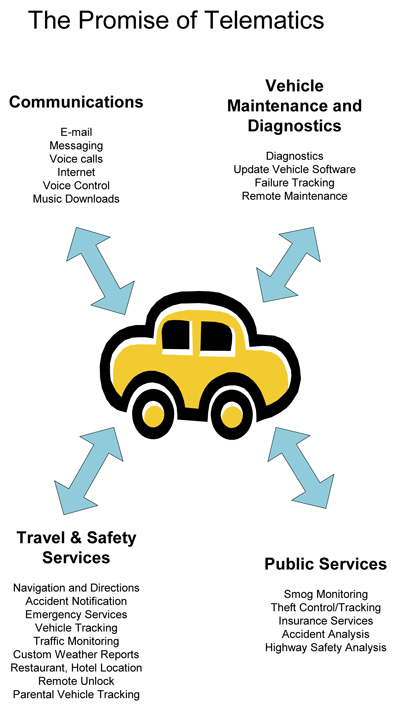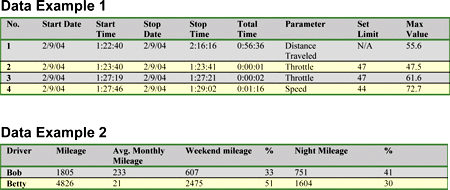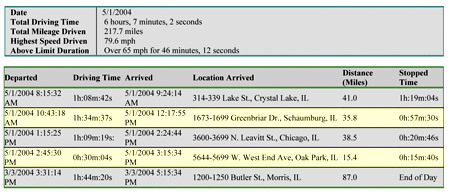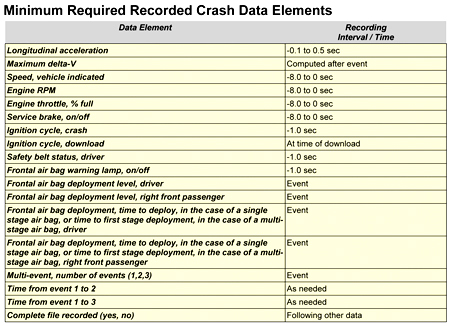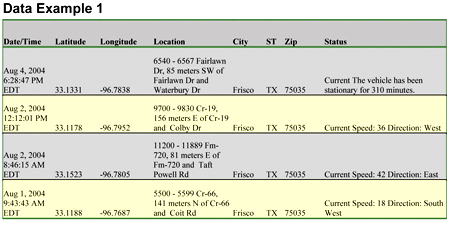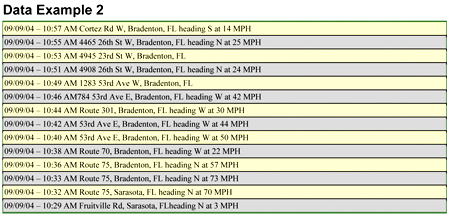|
|
IS VEHICLE DATA RECORDING AUTO INSURANCE'S FUTURE?By
Daniel Finnegan, PhD and Christopher Sirota, CPCU
Vehicle data recorders and telematics are not a future possibility, but currently available technologies. As costs decrease, many industries, including insurance, are taking a second look at utilizing these devices to improve services, and to develop innovative solutions. Auto insurers need to be aware of what is possible now and in the near future. This article presents a brief overview of available devices, and their potential future in insurance.
There are four basic types of "black boxes":
These aftermarket devices connect to the diagnostic link of a vehicle's operation systems and record data such as distance traveled, speed, braking and engine status with a time/date stamp. The stored data is then downloaded to a PC or a PDA. This type of device is being evaluated by the Federal Motor Carrier Safety Administration (FMCSA) for use in commercial vehicles to comply with the Hours-of-Service Rules. Current Market Examples
Examples of the data and output of these devices is contained in Appendix A to this report. Appendix B contains hyperlinks to referenced sources and products.
These aftermarket devices are similar to the trip-logging device with the addition of geographic coordinates provided via a GPS system. These devices do not allow real-time access to vehicle locations since the stored data is downloaded after the fact; however, they can offer a higher resolution of data than active tracking systems that charge for each wireless upload of position information. Current Market Examples
These OEM and aftermarket devices, what the National Highway Traffic Safety Administration (NHTSA) calls event data recorders (EDR), record a snapshot of data before and after a crash. Typical data includes speed, brake position, change in velocity and airbag deployment status. Some airbag modules, like GM's, record data, and are considered a type of EDR. The NHTSA proposed rulemaking would require that EDRs (e.g. airbag modules) voluntarily installed in private passenger and other light vehicles record a minimum set of data elements in order to improve vehicle safety research, effective in 2008. Approximately 15% of the 200 million light vehicles on the road today and over 65% of model year 2004 light vehicles have an airbag module that records some pre-crash data. Current Market Examples
A vehicle data recording device that communicates data wirelessly is called a telematic device. GM's OnStar is the best-known telematics application in the American auto market, with ATX Technologies the second largest player. In addition to being wireless, these devices can also monitor vehicle data in real-time. The following chart displays the many potential applications.
With the many potential benefits, one would think that every car would have a telematic device, however the numbers are low. In the U.S., about 3 million consumers subscribe to a Telematics Service Provider (TSP), out of about 200 million registered passenger vehicles. In addition, 30-50% of long-haul trucking companies and public transit entities, approximately 1 million vehicles, use telematics in fleet management (according to the C.J. Driscoll & Associates' U.S. Fleet Automatic Vehicle Location Market Study, 6/4/2003). Device costs are still high and, for telematics, drivers typically must subscribe to a TSP for a monthly fee that many are not willing to pay. OnStar, for example, has an initial price that varies by vehicle, and ranges from $500 to $1200 plus a $17 to a $70 monthly fee in the second year. Commercial vehicle tracking services can cost about $1000 per vehicle plus a $30 or more monthly fee depending on data usage. Current Market Examples
Large software and hardware companies like Microsoft and IBM have grown impatient with OEMs and have begun their own efforts:
Vehicle data recorders hold great promise for auto insurance. For underwriters, tracking data devices can provide verification for annual mileage, commute distances, and garaging location: three rating variables Quality Planning Corp. audits have shown to cause $4.2 billion in annual industry-wide premium leakage due to rating error. For actuaries, it can provide modeling data to determine new rating variables, and improve the quality of current variables. For claims adjusters, crash data can help weed out bodily injury and physical damage fraud, help determine negligence, and generally speed up the adjusting process. In addition, telematic devices can seamlessly stream these data to ensure quality data capture, and provide real-time accident alerts.
Safety has always been a concern of auto insurers. Worldwide, telematic monitoring of driver performance pilot programs have demonstrated major reductions in accidents. Berlin taxi accidents fell 66 percent after installation of telematic tracking. A European Union telematics pilot found telematics reduced the accident rate by 28 percent and costs by 40 percent. Emergency services and fleet users of telematics report accident reductions over 20 percent. These driving modification safety benefits, the so called "halo-effect" would impact future loss costs only with widespread use of such devices, which looks unlikely in the near future due to the high costs involved.
Despite the cost of the devices and services, the cost of revising an IT system, the lack of standardized data elements, privacy concerns, and the low demand from auto customers both private and commercial, some auto insurers here and abroad are taking a second look at the field:
The data from the above usage-based programs could vastly improve the accuracy of auto risk rating and provide those telematic-savvy insurers with a major competitive advantage. The detailed usage data offer a whole new level of risk measurement, in addition to verifying underwriting data, by monitoring variables like average speed, rapid acceleration and braking, hours of vehicle use, and types of roads driven. For example, it is possible to know that an insured driver left his home at 12:00 AM, drove to a bar, left the bar at 2:00 AM, drove down a 25 mile-per-hour street at 55 MPH and ran three stop signs on the way home. Such information, however, immediately raises important privacy concerns.
Privacy concerns tend to dominate any discussion of vehicle data recording and insurance. Would the average driver want his or her insurer to have access to the type of personal information listed above? The answer in most cases is likely to be no. Therefore, resolution of the privacy issue is likely to be a major shaping influence on the future of vehicle data recording in insurance. One way to address the privacy concern is to allow the owner of the data to choose who has access to the data in return for benefits. With access to the data in the hands of the insured, several paths toward widespread implementation of usage-based insurance become conceivable. First, owners of commercial fleets do not have the same privacy concerns as individual drivers. They want to know exactly where their vehicles are located, how fast they are being driven, and so on. If they could reduce their insurance costs through telematics it is reasonable to expect a majority will take the opportunity. Second, parents of teenage drivers may also desire the joint benefits of monitoring their children’s driving and reducing premiums. Third, individuals with seldom-used vehicles may provide a large market for Pay-As-You-Drive insurance with mileage verified through vehicle data recording. Fourth, individuals with good driving habits might desire the opportunity for lower premiums associated with vehicle data recorder verification of their safe habits. Fifth, a graded usage-based insurance approach could be adopted where different levels of discounts apply based on the amount of data the insured permits their carrier to access. Sixth, telematics insurance may come in as an add-on to other consumer telematic features such as navigation, road safety services, traffic control and toll collection. Seventh, the privacy issue might just go away. Remember the privacy concerns that were raised with the introduction of price scanners in supermarkets? At the time, privacy advocates were alarmed that matching purchase databases with credit or membership card identifications would produce big-brother databases with major corporations tracking all of their life-style information. Today, price scanners are just an accepted part of life. Perhaps, in the future, the telematics-equipped car will be just one more element of an all-encompassing information system. Eighth, legislation may resolve the competing privacy issues in a way that protects insureds and opens secure and private pathways for usage-based insurance.
The future of telematics and vehicle data recording development remain uncertain. Market analysts have reduced their forecasts. To date, consumer demand has been low at the prices offered. Exactly how much auto consumers are willing to pay by type of device or service is unknown at this time. Many technical issues are unresolved. For example, is the primary communication channel likely to be cell phone, satellite, dedicated short-range communication (DSRC), WiFi or other? We do not know how much this market will be controlled by auto manufacturers, aftermarket vendors, or government services. Before insurance uses can be even considered, many more cars have to be equipped and many more drivers have to subscribe. Even when these devices do become cost-effective, we still do not know how best to rate auto risk using recorded vehicle data. In addition, especially important for personal auto, the regulatory environment of usage-based auto insurance is in its infancy; its dimensions can only be guessed. Therefore, since the number of equipped vehicles is low, and will remain low in the near future, insurers cannot afford to wait for new technology while watching billions of dollars in premium and claims leakage. Insurers must enhance monitoring and verification of auto rating, improve the claims process, and fight fraud through available technologies to gain the competitive advantage. Quality Planning and ISO continue to research telematics and vehicle data recording as part of our larger program to promote rating integrity in auto insurance. Given the great promise of these technologies in auto insurance, and their great uncertainties, our recommendation is to utilize technology and data that are within our reach.
EXAMPLES
OF OUTPUT DATA FROM THE FOUR 1. Trip-logging Devices - Data Examples 1 & 2
2. Passive GPS Tracking Devices
3. Crash Data Recording Devices The table below shows the minimum set of recorded data elements to be required in NHTSA's proposed EDR rulemaking.
WEB LINKS Aioi
Insurance
© 2015 TLC Magazine Online, Inc. |

